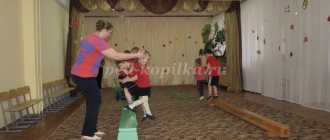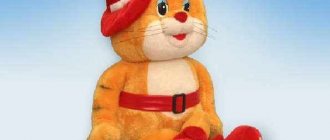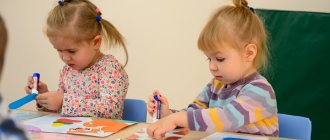Senior group. Senior preschool age. Children 5-6 years old
Summary of a lesson on reading the fairy tale “The Gruffalo” by J. Donaldson for older adults The main idea: do not be afraid, with resourcefulness and ingenuity, even the smallest mouse can outwit all hungry predators. Analysis: adjectives - huge mouth, dense forest, excellent appetite, dinner table, stewed, monstrous mouth, edge, amazing….
Abstract of the OOD on speech development “Reading K. Chukovsky’s fairy tale “Telephone” for children 4–5 years old Goal: To please children by reading a funny fairy tale . Practice dramatizing excerpts from the work. Objectives: Educational: teach to listen carefully; enter into dialogue. Developmental: develop the ability to use both short and common forms of answer; develop…
Card index of fiction in the senior group according to the Federal State Educational Standard with goals
Card index of fiction in various educational fields in the senior group According to the program “From birth to school”, ed.
N.E. Veraksy O.O. Contents Author, title Purpose Moral education RNS “The Fox and the Jug” arr. O. Kapitsa Cultivating good feelings; formation of ideas about greed and stupidity RNS “Winged, hairy and oily” arr. I. Karnaukhova Teach children to understand the character and actions of the heroes of X. Mäkel. "Mr. Au" (chapters), trans. from Finnish E. Uspensky rns "Khavroshechka" arr. A. N. Tolstoy Cultivate manifestations of good feelings towards each other; RNS "Bragging Hare" arr. O. Kapitsa To educate the norms of moral behavior rns “The Frog Princess” arr. M. Bulatov Cultivate kindness and a sense of mutual assistance. B. Shergin “Rhymes” Cultivate a respectful attitude towards other people rns “Sivka-burka” arr. M. Bulatov To develop in children the ability to evaluate the actions of heroes, to express their attitude towards them RNS “Finist-Clear Falcon” arr. A. Platonov Cultivate a sense of compassion for others V. Dragunsky “Childhood Friend”, “Top down, diagonally” Cultivate attentiveness, love, compassion for a close comrade S. Mikhalkov “What do you have?” Nenets fairy tale “Cuckoo” arr. K. Sharov To promote kindness, attentiveness and responsiveness to relatives “Goldilocks”, trans. from Czech K. Paustovsky; cultivate the ability to empathize, be generous, and not envy others; develop self-respect and mutual assistance in work. "Three golden hairs of Grandfather the Omniscient", trans. from Czech N. Arosieva (from the collection of fairy tales by K. Ya. Erben). V. Dmitrieva. “Baby and the Bug” (chapters) Feel and understand the character of the images of L. Tolstoy’s literary work “The Bone” Cultivate the moral qualities of the individual: honesty, truthfulness, love for family. L. Tolstoy “The Jump” To awaken in children empathy for the hero of the story N. Nosov. "Living Hat"; To form children's ideas about moral standards with the help of children's literature. S. Georgiev. “I saved Santa Claus” Develop the ability to evaluate one’s own actions and the actions of heroes, cultivate friendliness, and the ability to interact with peers A. Lindgren. “Carlson, who lives on the roof, has arrived again” (chapters, abbr.), trans. with Swedish L. Lungina K. Paustovsky. “The Thief Cat” To cultivate moral qualities: a sense of compassion, empathy Adam Mitskevich “To Friends” To generalize and expand children’s knowledge about such concepts as “friend”, “friendship”, “honesty”, “justice” P. Bazhov “Silver Hoof” To educate a feeling of kindness, caring for the weak R. Kipling. "Little Elephant", trans. from English K. Chukovsky, poems in translation. S. Marshak To foster a culture of behavior, friendship, mutual assistance, care for loved ones V. Kataev. “Tsvetik-semitsvetik” To develop the ability to present the characteristics of one’s personality among peers, reflecting achievements and the reasons for possible difficulties. Child in the family and in society RNS "Khavroshechka" arr. A. N. Tolstoy Introduce different family relationships by Yu. Koval “Grandfather, Grandmother and Alyosha” Form in children an idea of a family as people who live together, love each other, take care of each other. V. Dragunsky “Deniska’s stories” Formation of ideas about the characteristic qualities of boys and girls. A. Gaidar. “Chuk and Gek” (chapters) Learn to assess the relationships between close people in the family, compile characteristics of the heroes of E. Grigoriev’s “Quarrel” Develop the basics of social interaction between boys and girls; a friendly attitude towards the opposite sex A. Barto “Vovka is a kind soul” E. Blaginina “Let’s sit in silence” Continue to form children’s idea of a kind attitude towards their mother A. Usachev “What is etiquette” Continue teaching the culture of verbal communication in kindergarten and at home “Krupenichka” N. Teleshov Cultivate interest in fairy tales, in Russian traditions Self-service, work RNS “Khavroshechka” arr. A. N. Tolstoy To form children’s ideas about a hardworking person K. Chukovsky “Moidodyr” Education of cultural and hygienic skills K. Chukovsky “Fedorino’s grief” rns “At the command of the pike” To consolidate in children the concept of the importance of human labor A. Barto “The grimy girl” » Cultivate neatness and careful attitude towards personal belongings and belongings of Comrade Yu. Tuvim. “A letter to all children on one very important matter,” trans. from Polish S. Mikhalkova Formation of the foundations of security S. Mikhalkov “Uncle Styopa the policeman” Reinforcing the rules of behavior on the streets of the city E. Segal “Cars on our street” Cognitive development of FEMP Reading books Heroes of fairy tales S. Marshak “Numbers” Acquaintance with numbers Acquaintance with the social world G H. Andersen “Snowman” Introduction to New Year’s traditions of different countries S. Mikhalkov “What do you have?” Introduction to the importance of any profession "Wonderful stories about a hare named Lek", tales of the peoples of West Africa, trans. O. Kustova and V. Andreeva; Acquaintance with the characteristics of the peoples of West Africa A. Gaidar “The Tale of a Military Secret, Malchish-Kibalchish and His Firm Word” Continue to expand children’s ideas about the Russian army. Nenets fairy tale “Cuckoo” arr. K. Sharov Acquaintance with the life of the peoples of the far north M. Boroditskaya “Waiting for a brother” To form a desire to take care of children, to develop a sense of responsibility and respect for younger comrades A. Tvardovsky “The Tankman’s Story” To form in children an idea of the feat of the people who stood up for the defense of their Motherland . A. Barto “The Herd Game” Expand children’s knowledge about their kindergarten, draw attention to its history, clarify ideas about the work of kindergarten employees S. Makhotin “Senior group” O. Vysotskaya “Kindergarten” T. Aleksandrova “Kuzka the Brownie” (chapters) Cultivate interest in the life of Russians in ancient times, love for the history of their people M. Isakovsky “Go beyond the seas and oceans” Clarify knowledge about your native country. B. Almazov. “Gorbushka” Introduction to Russian values; Introduction to the natural world rns “Bragging Hare” arr. O. Kapitsa To form children’s caring attitude towards nature, the desire to take part in its conservation and protection. L. Tolstoy. “Lion and Dog”, “Bone”, “Jump” Expand ideas about the life of animals G. Snegirev “Penguin Beach” K. Paustovsky. “Cat Thief” Foster love and respect for nature, kindness; V. Bianchi “Owl” Continue to form an idea of the interconnection and interdependence of living beings, an idea of the literary genre “educational fairy tale”; B. Zakhoder “Gray Star” To cultivate a sense of empathy and love for nature and man, the ability to resist evil S. Yesenin “Bird cherry” To help feel the beauty of nature in R. Kipling’s poem. "Little Elephant", trans. from English K. Chukovsky, poems in translation. S. Marshak Develop fine motor skills of the hands, attention and interest in the animal world and its diversity P. Bazhov “Silver Hoof” Cultivate a sensitive attitude towards animals, love for nature Speech development Development of all aspects of speech Acquaintance with genres Explanation of unfamiliar, outdated words Artistic and aesthetic development Introduction to art V. Konashevich Acquaintance with illustrators I. Bilibin E. Charushin Fine arts activity Drawing illustrations based on works Musical activity P. I. Tchaikovsky “The Nutcracker” (fragments) Acquaintance with the musical depiction of heroes and images of works by P. I. Tchaikovsky “The Seasons” (fragments) N. A. Rimsky-Korsakov “The Tale of Tsar Saltan” (fragments) S. Prokofiev “Peter and the Wolf” Physical development of GCD and leisure activities based on the plots of the works Heroes of the works
Download Card index of fiction in the senior group according to the Federal State Educational Standard
We recommend watching:
Notes for a math lesson in the senior group “Kolobok's Journey” Notes on speech development in the senior group “Poultry” Intellectual Olympiad for senior preschool children in kindergarten Consultation for preschool teachers. Development of sound culture of speech in older children
Similar articles:
Cultivating cognitive interest in social reality in children of senior preschool age
Surprising moments in kindergarten classes. Card index
Kindergarten teacher business card
Presentation of kindergarten for parents
Morning exercises in kindergarten in the preparatory group
The relevance of the problem of social and moral education in preschool educational institutions
Currently, the problem of social and moral education is very relevant and complex.
Changes in society, criticism of certain processes of social life, the emergence of new social phenomena have led to the fact that manifestations of kindness and compassion, love and empathy have become increasingly rare. In society, material values have come to the fore; they prevail over spiritual values. Manifestations of child cruelty and aggressiveness of children towards each other and towards loved ones are becoming more and more common. It has become more difficult for children to build friendly relationships; it is difficult for them to agree on joint actions during play activities. Modern cartoons rarely pursue the task of moral education, therefore, under the influence of these cartoons, children's ideas about moral qualities - about mercy, justice and kindness - are distorted. But despite the changes taking place in society, the education in children of moral qualities, emotional attitude towards loved ones and others must remain unchanged. Therefore, the moral education of children is one of the key tasks.
Are you an expert in this subject area? We invite you to become the author of the Directory Working Conditions
Preschool age is the most sensitive for developing moral rules and norms of behavior, the ability to empathize and compassion. That is why it is necessary at this age to lay the correct foundations of the child’s personality. At preschool age, the formation of the child’s personality begins, his worldview, understanding of evil and good, reaction to the actions of other people are formed, and behavioral characteristics are formed. At this age, the child develops an attitude towards the Motherland, respect for others, goodwill, and a desire to help others.
Solid memory and logic
To remember all the characters in War and Peace and understand the twists and turns of the plot, you need not only strong nerves, but also developed memory and logic. By working your way through a difficult novel, you extend the life of your brain.
Proven by RS Wilson, PA Boyle et al. Life-span cognitive activity, neuropathological burden, and cognitive aging / Neurology that avid readers in old age are 32% less likely to suffer from Alzheimer's disease.
The longer the piece you choose, the better your brain works.
Rich imagination and imaginative thinking
“The author only writes half of the book. The other half is written by the reader,” said the classic of English literature Joseph Conrad. A good writer does not really tell everything, but only the essentials, forcing the reader to use his imagination. The appearance and background of the characters, the setting, the smells, the timbre of the voice - as directors filming a film adaptation, we often come up with the details ourselves.
If you have a hard time imagining, take up fiction. It will spark your imagination.
Rich vocabulary
Research results from Reading habits / TestYourVocab.com show a direct relationship between the amount of fiction read and vocabulary. The table shows the results of a survey of 30-year-old readers.
| Reading habits | Vocabulary, words |
| Read a lot, a lot of fiction | 29 558 |
| Read a lot, sometimes fiction | 28 299 |
| Read a lot, rarely read fiction | 24 064 |
| Read sometimes, sometimes fiction | 23 353 |
| Read sometimes, rarely read fiction | 21 947 |
| Rarely read, rarely read fiction | 12 402 |
If you want to speak beautifully, read fiction. This way you will learn to better formulate thoughts and tell stories, and get rid of cliched phrases in speech and writing.
Coming to terms with uncertainty
Stability is a myth, but novel connoisseurs are of little concern about this. Study by M. Djikic, K. Oatley, MC Moldoveanu. Opening the closed mind: The effect of exposure to literature on the need for closure / Creativity Research Journal demonstrated that people who read fictional stories have less need for cognitive certainty than those who read nonfiction.
In an experiment, 100 students from the University of Toronto read one of eight short stories or one of eight essays. Afterwards, everyone filled out a questionnaire assessing their level of emotional need for certainty and stability. The results showed that participants who read the stories had an easier attitude towards chaos and instability. This means they think more broadly and approach problems creatively.
Developed empathy
Reading fiction develops Novel finding: Reading literary fiction improves empathy / Scientific American empathy and helps to imagine oneself in the place of another.
This is due to the fact that the brain processes read and real information in the same way. The left temporal lobe, which is responsible for the perception of language, makes the brain think that it is doing what the hero of the story is actually doing. This phenomenon is known as “embodied cognition.” As we read, we literally move into the character's body.
Thanks to fiction, we stop focusing on ourselves and begin to understand the behavior and motivations of others.




